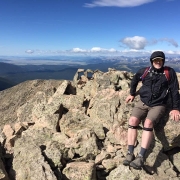Our Country’s Greatest Scourge – Reflections on “It was Me all Along: A Memoir,” by Andie Mitchell | Healthy Aging Series: Season 9, Episode 2
I am a cyclist. I don’t ride as much as I used to ride because my primary sport is backpacking and I’m usually preparing for backpacking trips to places like the Red River Gorge, the Smokies, the Grand Canyon, Colorado, or Utah. When I was 55, I rode my bicycle across the state of Indiana…











